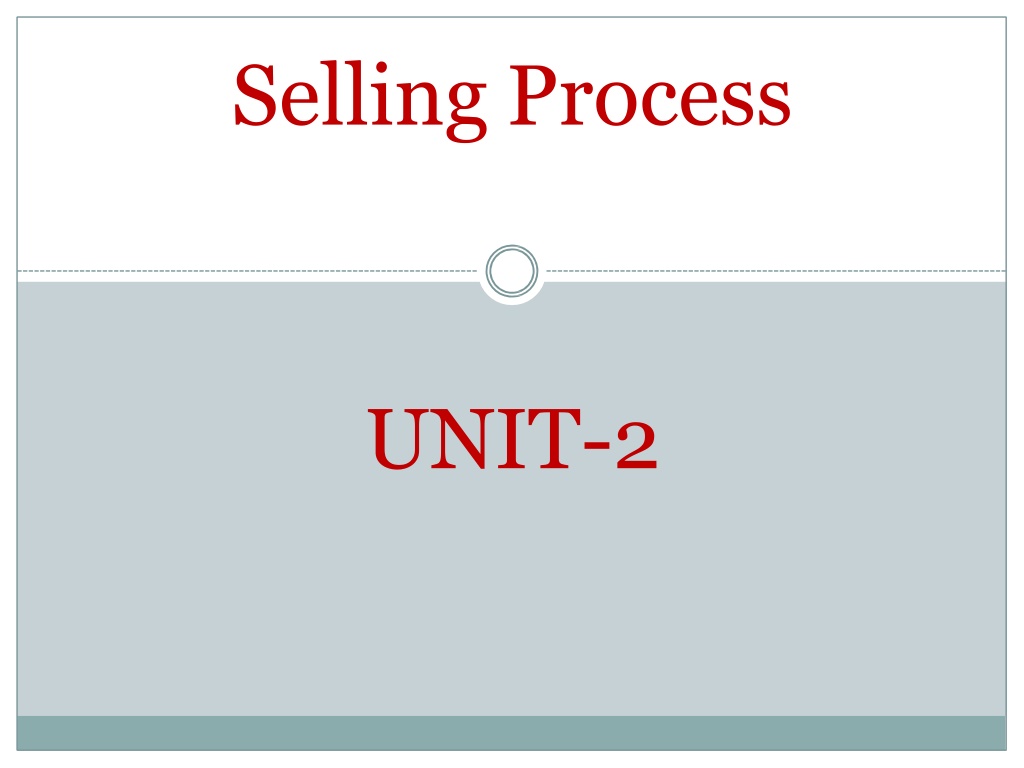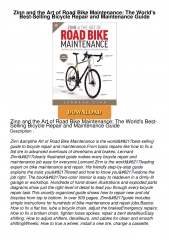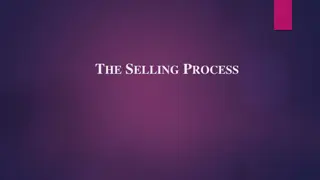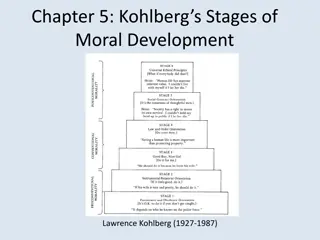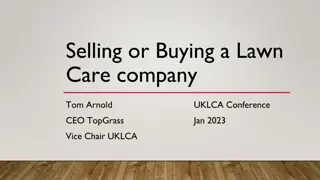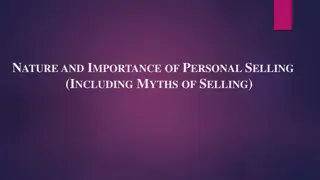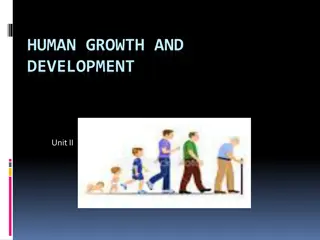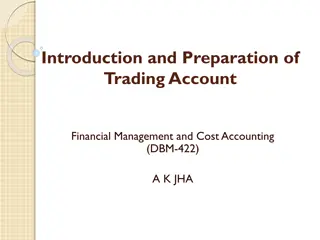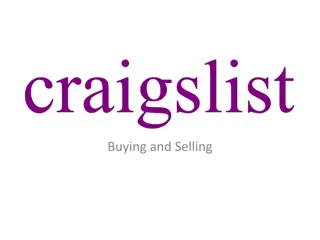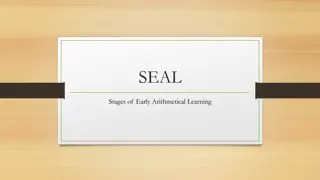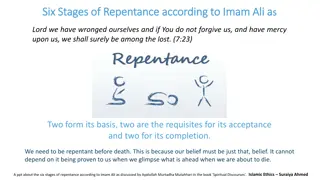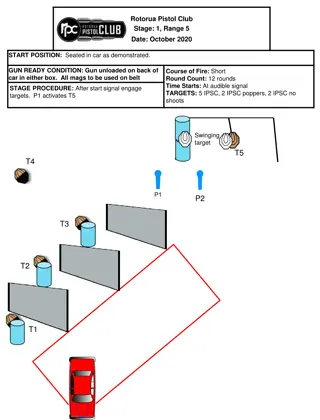Understanding the Selling Process: Stages and Importance
The selling process is essential in today's competitive market environment, where producers need to persuade consumers to purchase their products. It consists of stages such as prospecting, pre-approach, approach, presentation, handling objections, closing the sale, and follow-up. Prospecting involves identifying potential buyers, while pre-approach focuses on gathering information about prospects. Approach signifies the actual contact with the customer, presenting the product or offer. Each stage plays a crucial role in successful sales execution.
Download Presentation

Please find below an Image/Link to download the presentation.
The content on the website is provided AS IS for your information and personal use only. It may not be sold, licensed, or shared on other websites without obtaining consent from the author. Download presentation by click this link. If you encounter any issues during the download, it is possible that the publisher has removed the file from their server.
E N D
Presentation Transcript
Selling Process UNIT-2
Selling Process Synopsis of the Chapter:- Meaning of Selling Process Stages or Steps In Selling Process
MEANING OF SELLING PROCESS In primitive days, demand preceded the supply and therefore, there was no need to do any effort to sell one's own products. But as there is progress in society, production is no longer carried on, on a small scale but on a large scale. Even one product is produced not by one producer but by several producers, such as cotton textiles , steel , shoes , paperetc. It results in overproduction and competition among theproducers. The consumer is considered as the King ofmarket. The producer follows different steps, one by one so as to persuade the consumer to buy his product that will give him satisfaction. The steps taken by the salesman to perform his function of selling successfully are included in selling process.
STEPS IN SELLING PROCESS Prospecting 1 Pre-Approach [Planning the Sales Call] 2 Approach [ Selecting the Presentation Method ] 3 Presentation and Demonstration 4 Meeting or Handling Objections 5 Closing the Sales 6 Follow - Up 7
1) PROSPECTING Prospecting is the 1stand the foremost stage of the selling process. Prospecting means identifying and locating Potential buyers. It helps in planning the whole selling efforts so that there is no or minimum of wasted calls. Regular and systematic prospecting is the foundation of all selling.
2) PRE-APPROACH Pre-approach is the 2nd stage of the selling process. The salesman is to acquire enough information about such prospects in order to approach each one in the most effective manner. Pre-approach involves developing an understanding about those prospective buyers who have been identified and on whom the salesman proposes to call. This understanding may relate to buyers' needs , personality drafts and behavior patterns which are critical to their buying decision. Pre - approach prepares effective background of making approach and ascertains the best and the most effective method of approaching the prospect.
3) APPROACH Approach is the 3rd stage of the selling process. When the salesman comes in actual contact with the prospect or likely customer, the next stage, namely, the 'approach' is reached. The face-to-face contact with the prospect is termed as approach. It involves use of different methods for seeking an access to the prospect so that the product/offer may be presented to him.
4) PRESENTATION AND DEMONSTRATION It is the 4th stage of the selling process. In this step, the salesman demonstrates to the customer the need-satisfying characteristics of the products being offered for sale. The objective of presentation and demonstration is to help in convincing the customer that the salesman's product is the best one for satisfying his needs. In this way, effective presentation and demonstration plays a vital role in the selling process.
CONT:- demonstration can be done through AIDA Effective approach. According demonstrated in such a manner that it gains the customer's attention, holds his interest builds up his product, and ends up in purchase action. to this approach, the product should be desire for the
5) MEETING OR HANDLING OBJECTIONS It is the 5th step in the selling process. Under this step the salesman is required to handle and over come objections arising during or as a result of presentation and demonstration, it is just natural for the customer to ask questions, raise objections and seek explanation. It is the most difficult situation that a salesman is required to face. The salesman's job is to effectively meet, handle and answer them in a most convincing and systematic manner.
6) CLOSING THE SALES It is the 6th stage of the selling process. After having answered and overcome objections, it is the right time for the salesman to clinch the deal by closing the demonstration. The object of closing the sale is to get the customer in the mood of saying 'yes' so that the salesman can ask for the order. It is a very important step of the selling process. The salesman is expected to perform the same in a very decent manner.
7) FOLLOW - UP It is the 7th and last stage of the selling process. After closing, it is important for the salesman to follow up the order booked so as to ensure that the order is properly executed. Follow-up is also necessary to gather information from the customers regarding product use,problems, if any, and the level of customer satisfaction. It builds up goodwill, ensures feedback and encourages repeated purchases.
PROSPECTING Just as the prospector in case of mining explores with a view to finding valuable mineral deposits, in the same way the salesman looks for and explores valuable prospects, that is, persons who are in need of his product. The need can be converted into want and the same may finally be converted into purchases. Prospecting means finding out qualified and potential customers. In other words, prospecting is the method of finding out the prospects or likely customers.
CONT:- Actually selling process starts with prospecting. Regular and systematic prospecting is the foundation of all selling. A salesman is constantly on the lookout for prospects, which means he is looking out for Individuals, whom he can ultimately convert into buyers. In this case, we must remember that prospecting is not a wild goose chase. It is a systematic and continuous search of a potential customer.
CHARACTERISTICS OF A GOODPROSPECT Prospecting is as wide as a desert; but it does not mean that because it is desert, oil can be found everywhere. Prospects are too many, for that reason every human being may be considered as a prospect. But this concept is wrong. It is not correct to consider everyone to be a prospect without first determining whether these individuals possess the necessary characteristics of a good prospect. Thus it is most essential for an efficient salesman to know the characteristics of a good prospect.
CONT:- In this connection the main characteristics of a good prospect are as follows: Does the Prospect Have a Need? Does the Prospect have Ability toPay? Does the Prospect have Ability toSacrifice? Does the Prospect have the Authority toBuy? Is the ProspectApproachable? Is the Prospect Eligible to Buy?
1) Does the Prospect Have a Need? The first and the foremost characteristic of a good prospect is that he must have the need of the product. A need must exist which is capable of being converted into a want and a want into purchase. In case the prospect does not have the need of the product in question then it is the responsibility of the salesman to see that the need is created by means of creative salesmanship.
2) Does the Prospect have Ability to Pay? The second characteristic of a good prospect is that he should have the ability to pay. Because if wishes were horses even beggars could ride them. Mere desire or want is not sufficient. It must be an effective want duly backed by the ability to pay. Ability to pay means possessing enough financial resources to make the payment.
3) Does the Prospect have Ability to Sacrifice? Simply having a want and ability to pay is not enough; the prospect should also have the ability to sacrifice. For instance, take the case of a miser. He possesses both, i.e. the want and the ability to pay but the ability to sacrifice is lacking. Thus his desire or want cannot be converted into purchase.
4) Does the Prospect have the Authority to Buy? The 4thcharacteristic of a good prospect is that he should have the requisite authority to buy. For instance, the son of a rich businessman desires a car but he does not have the requisite authority from his father to buy a car. In this case the salesman should approach the father and not the son for selling the car.
5) Is the Prospect Approachable? Really speaking, a big gap exists between a high, executive authority and the salesman, that of approachability. The salesman is required to cross many hurdles before approaching the high executive. The salesman should take into consideration, the nature, the status and the circle etc. of the high executive before making any approach to him.
6) Is the Prospect Eligible to Buy? The last but not the least important characteristic of a good prospect is that he should be eligible to buy. For instance, certain goods can be sold only to a licence- holder, such as gun or pistol, or at the recommendation of a qualified doctor, such as medicine. From the above discussions, it is evident that a good prospect is one who has the need to buy, has ability to pay, is prepared to sacrifice, has authority to buy, and is approachable and also eligible to buy.
METHODS OF PROSPECTING OR SEARCHING FOR THE PROSPECTS The salesmen from time to time for prospecting or searching the prospects are employing different methods. The important methods which are usually employed for prospecting by the salesmen are as follows: Cold-Canvass Method. Endless Chain or Family Tree Method. Centre-of-influence Method. Personal Observation Method. Junior Salesmen and Bird Dog Method. Trade Fairs, Exhibitions and Demonstrations. Miscellaneous Method.
1) COLD-CANVASS METHOD The cold-canvass method or, as is popularly known in America, Cold-turkei calling , is also resorted to by salesmen to increase the number of their prospects. In this method a salesman prepares a list of individuals or firms who are most likely to purchase his product on certain presumptions. For instance, let us suppose that an office stationery salesman assumes that wherever there is an office there is the need for office stationery. Having prepared the complete list of all the offices that exist in his sales territory, he starts converting each one of them on a certain plan.
CONT:- His plan is to visit five such offices everyday and leave his name and address behind. Within the course of a month he wil have covered about 140-150 such offices. Later on, he will start making calls in those offices.It is likely that some calls may be successful and some may not. In case of unsuccessful calls, he may continue to make calls in the next month or on the appointee date and time and so on. This method is most common now-a-days. Mostly those salesmen who are hard working and untiring in energy adopt this method.
2) ENDLESS CHAIN OR FAMILY TREE METHOD Another method of increasing the number of prospects is called Endless Chain or Family Tree Method . This is a term applied to the process of securing an endless number of prospects. This is a very useful and popular method for securing new customers. Under this method, when a salesman interviews any customer, he secures the names of some prospects for future interviews.
CONT:- For instance, he may ask the customer to give names of two or three acquaintances, relatives or friends who may be interested in what he is selling. Thus one prospect leads to another and an endless chain of prospect is formed. The advantage of this method is that it is a continuous process and an intelligent salesman would in this way collect a mass of information about relatives friends and associates etc. who may be potential customers in the near future.
3) CENTRE-OF-INFLUENCE METHOD In this method, the salesman consults influential persons in his locality or territory such as bankers, teachers, doctors, leading politicians, business executives, club official etc. about their acquaintances, relatives, friends etc. who may turn out to be potential customers. This method is a modification of the endless chain method.
4) PERSONAL OBSERVATION METHOD This is also an important method of prospecting. Just as dogs are employed by the police to find out a culprit who is guilty of some crime, similarly experienced salesmen are employed to discover a good prospect. The personal observation of the salesman for a prospect is not merely confined when he is on duty. He will remain constantly on lookout for bits of information of value to him, whether on way to the work, in the office at a dinner party or any social function.
5) JUNIOR SALESMEN AND BIRD DOG METHOD It is also an important and popular method used by the salesman for identifying the prospects. In this method, junior salesmen are employed to call at the door of every house in a particular locality of community, inquire about the type of product which is being used, and from the reactions obtained, an attempt is made to get an appointment at a later time for the experienced salesman to explain the features of their latest product.
CONT:- This method is usually applied for selling costly domestic products, such as washing machines, grinding machines, refrigerator or even automobiles etc. Bird dog' is a name given to water and electric meter readers. In this method, the salesman contacts them whom, on certain payment, give a clue as to kind of prospects residing in a particular locality. On the basis of the clue the salesman picks out certain person only and tries to sell his product to them.
6) TRADE FAIRS, EXHIBITIONS AND DEMONSTRATIONS Participation in trade fairs and exhibitions etc. is another method of prospecting. Many companies display or demonstrate their products in trade-fairs and exhibitions organized at state level, country level or even world level. Care is taken to obtain names and addresses of individuals and firms etc. who appear to be interested in the company's products.
7) MISCELLANEOUS METHOD There are other miscellaneous methods of prospecting. They include inquiring on the telephone, use of direct mail (sending of a circular letter enclosing a return card), launching advertising campaign, using trade directories etc.
PRE-APPROACH Pre-approach commences as soon as the salesman obtains the name and address of prospect. Prospecting is generally completed when the salesman feels that he knows enough about the prospect and there is a chance of selling to him. Pre-approach is a fact-finding stage of selling process in which additional information, other than that about the prospect, such as his likes and dislikes, habits, type of buying motive, economic status etc. which will enable him to plan his selling campaign intelligently.
CONT:- The salesman by means of pre-approach ascertains the best and the most effective method of approaching the prospect. For instance, a doctor before prescribing any medicine diagnises the disease of the client. Similar is the case with the salesman, who before starting his approach, plans the approach and, therefore, this process is known as pre-approach.
OBJECTIVES OF PRE-APPROACH The main objective of pre-approach is to help the salesman get further insight into the customer's needs and attitude so that he can select the best approach for the individual prospect. Through the pre-approach the salesman would know the prospect's likes and dislikes as well as his preferences. The pre-approach would provide to the salesman the complete picture of the prospect well in advance.
CONT:- Knowing this, the salesman can treat him as he likes to be treated. The objective of the pre-approach is to provide the salesman with all the information necessary to plan his sales strategy properly. Backed with the requisite information, the salesman can meet the prospect with full confidence.
APPROACH Approach means meeting the prospect face to face. It is the first appearance of the salesman with the prospect. Merely pre-approach is not enough to convert a prospect into a buyer; he must see him face to face. The sales strategy is complete only when a salesman comes face to face with the prospect.
CONT:- The pre-approach knows things only in part and to know him fully an approach is necessary. Approach is the most critical part of the selling process. At this time the salesman should create a favourable sales impressing on the prospect. To make a favourable sales impression the salesman must look as active sales professional.
METHODS OF MAKING APPROACH Nowadays-different salesmen for making approach with the prospect use different methods. The important methods are as follows:- The Personal Call without Introduction Sending to the Business Card Using the Telephone Writing for anAppointment Premiums or Door-Openers Introduction Sending Advance SalesLetters The Use of 'Trickery' for SecuringAppointments
1) The Personal Call without Introduction In this method, a request is made by the salesman to the prospect to give him an interview at once or at a future time as may be suitable to him. He may also attempt to utilize a little psychology with some powerful motive to overcome the prospect's instinctive antagonism to a stranger. Therefore, the appeal to profit or self-interest or appeal to curiosity is commonly employed to gain the interview with the prospect.
2) Sending to the Business Card In this method, the salesman to obtain an interview with the prospect uses the business card. Business cards, which have now become more or less a necessity, should have a distinctive appearance. The business card bears the name of the salesman along with the name and address of his company. In this connection one must remember that business card is not a passport to admission as it may be sent out as easily as it is sent in. It all depends on the desire of the prospect to allow admission or refuse admission.
3) Using the Telephone Telephone is an effective method for securing an interview with the prospect. This method is most suitable when there are a large number of prospects. The telephone approach must be aggressive and the conversation should be speeded up after the prospect has announced his name. Opening should be made with short sentences and the sales talk on the telephone should consist of only leading questions inviting the reply 'yes'. Arguments should be totally avoided.
4) Writing for an Appointment In this method, the salesman prefers to write letters to the prospects requesting appointment when he can approach them and put forward their proposition. A simple request for an appointment is likely to produce the desired result. However, the proposition must be presented in an attractive manner so that it may arouse the curiosity of the prospect.
5) Premiums or Door-Openers In this method, the salesman uses premiums or door openers to obtain the interview with the prospect. Small gifts are sent to the prospect to arouse his curiosity, and make him feel under an obligation to open the door for the salesman. Such gifts usually consist of paperweights, automatic pencils, ashtrays, toothbrush, diary, calendar and similar novelties.
6) Introduction Suitable introduction is one of the most effective methods of securing an interview with the prospect. In this method, the salesman approaches the prospect as an acquaintance or friend and not as a stranger. Instead of introducing himself, the salesman is required to deliver the letter or note of introduction to the prospect. Such an introduction may be obtained from a common friend, relative on acquaintance.
7) Sending Advance Sales Letters In this method, sales letters are mailed in advance by the salesman's company to the prospects intimating the date and the time of arrival of their salesman to the prospect's residence or office. These letters are carefully drafted, typed and signed by the important officials of the company. It is also an important method of approaching the prospect.
8) The Use of 'Trickery' for Securing Appointments This method of approach to the prospect is generally used only when the salesman, after encountering several refusals for an interview, feels certain in the mind about his ability to convert the prospect into a buyer. He may use recourse to trickery as a means of gaining the interview. The use of trickery is condemned and hence it should be used as a last resort only.
PRESENTATION Presentation or sales presentation is a process during which the salesman tries to attract the attention and the interest of the customer towards the product. Presentation helps in convincing the customer that the salesman's product is the best one for satisfying his need. A planned presentation saves the time of the customer and the salesman. It relieves the salesman of the nervous strain and gives him the much-needed confidence.
CONT:- Effective sales presentation is a vital force in selling. The customer normally r preaches the shop of the salesman with a vague idea of what he actually needs or wants. It is the sales presentation, which helps the customer in taking final decision for purchasing the product.
